Hidato is a logic puzzle invented by Gyora Benedek, a scuba-enthusiast mathematician who says he was inspired by watching the complex paths of fish while diving. There are numbers, but don’t worry – like Sudoku, they’re just symbols – there’s no mathematics involved!
In a hurry? Jump to: Rules / Tips / Worked Example / Video Tutorial / Download Free Puzzles / Books
The goal of Hidato is to fill the grid with consecutive numbers that connect horizontally, vertically, or diagonally. Here is a small sample Hidato puzzle:
The rules of Hidato are very simple: fill in all the missing numbers in the grid such that they connect consecutively from smallest to largest, touching horizontally, vertically, or diagonally. In other words, starting at 1, it must be possible to travel to 2, then 3, then 4 and so on, by moving between touching squares.
Here’s what our small sample puzzle looks like once it’s solved. We’ve overlaid the arrow to make it easier to see the path from 1 to 16:
Every puzzle has a single and unique solution. They are solved using a process of elimination. Here are some tips to help you, and then we’ll look at a worked example.
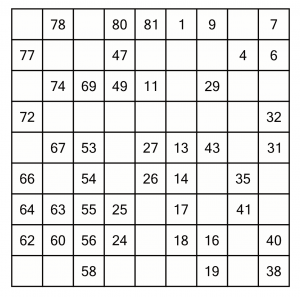
Here’s a bigger puzzle, though still an easy one. We'll work through step by step. If you want to print it out to play along, it's part of our Taster PDF you can download at the bottom of this page.
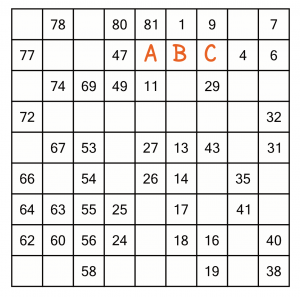
We’ll start at number 1, because starting at the beginning is as good a place as any for easy level puzzles. We know we need to place the 2 and the 3 somewhere (the next pre-filled number being 4). Starting from the 1, there are three cells available for the 2.
Although cell A touches the 1, we cannot possibly put the 2 in there, because we can’t get from there to the 4 in one cell. So the 1 goes in either B or C.
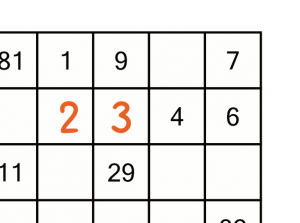
We could put the 2 in B and the 3 in C like this. At first glance this looks good. But there’s a problem. Can you spot it?
The problem is that to get from the 9 to the 11 we know we will have to put the 10 in cell B. So the 2 cannot go there.

It has to go in cell C, like this.
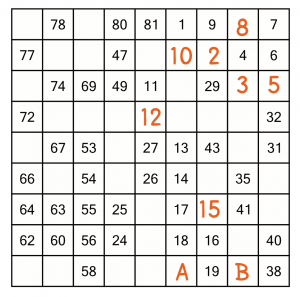
Now we have an easy run, using the same logic to fill in numbers all the way up to 19. You may notice that the 12 appears to have two possible placements, but only one is valid because we cannot block the path between 27 and 29.
We are faced with a choice for where we put the 20: cell A and cell B. It’s very easy to work out which must be the answer. The next printed number is 24, so that’s where we are headed. If we put the 20 in cell B, it won’t be possible to reach 24, it’s too far. So the 20 must go in cell A
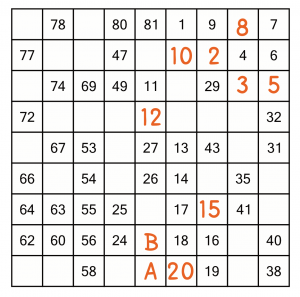
There’s another choice here. 21 could conceivably go in A or B – both let us get to 24. We don’t know which it is yet, so we’ll have to skip ahead.
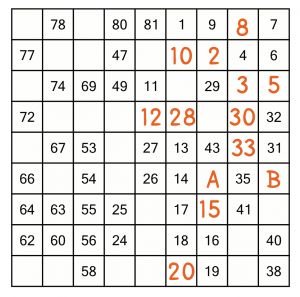
Counting up from the 24, we can get all the way to 33 with no decisions to make.
After the 33, we are faced with a choice, where to put the 34, in A or B? Again, the answer is simple because cell A is the only possible path between the 41 and the 43, so we must put the 34 in cell B, leaving A free for the 42.
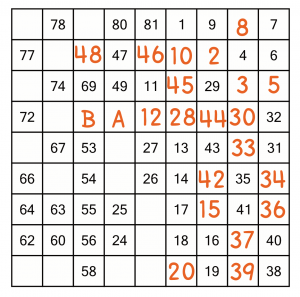
Once we’ve done that, we’ve got a clear run all the way to 49. We’ve already completed more than half the puzzle!
It’s not immediately clear whether we should place the 50 in cell A or B – either would work. Instead of worrying about that, let’s skip ahead.
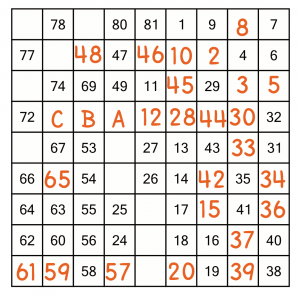
Counting from the 53, we can add in numbers taking us all the way to 67. The 68 could go in cell B or C. Looking around that area, we can see that we need to put the 73 somewhere, and maybe that goes in cell C, but it doesn’t have to, so we cannot use that to determine where the 68 goes.
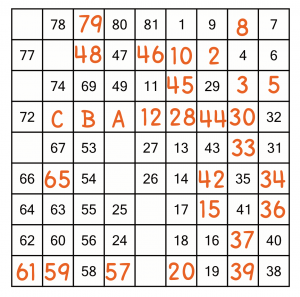
Let’s look and see if there are any other numbers we can definitely place. 79 is easy to spot.
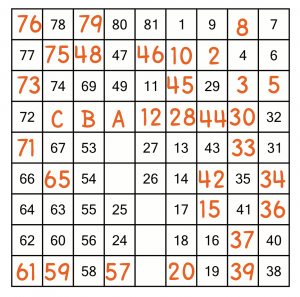
From there, we can keep counting backwards, placing the 76, 75, all the way down to 71.
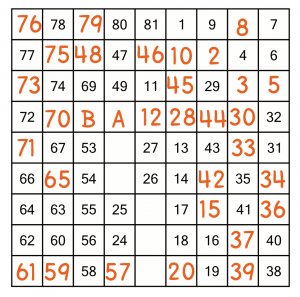
Now we know that cell C must contain 70...
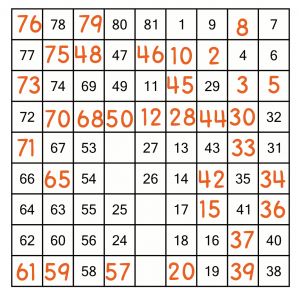
That means cell B must contain 68, which means A must be the 50 we couldn’t decide about earlier.
Now we can go back and fill in the rest of the cells – they are all easy. Can you do it? If you want to check your answers, have a look at the Hidato Taster PDF below – it’s got a few puzzles for you to try including this one, along with the solutions.
Ready to have a go yourself? We’ve put together a taster of four puzzles for you, including the example above. You can download and print the PDF below. Solutions are included, but no cheating!
You can get 120 fab Hidato puzzles over seven levels of difficulty in Puzzle Weekly Presents: Hidato. With one puzzle per page, there's plenty of space for notes and working out. Plus all the solutions are in the back so you can quickly check your answers.
We also publish Hidato puzzles in Puzzle Weekly from time to time. Puzzle Weekly is our free weekly puzzle magazine – find out more, and get your copy, here.